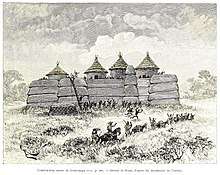Gurunsi peoples
The Gurunsi, or Grunshi, are a set of related ethnic groups inhabiting northern Ghana and south and central Burkina Faso.
| Total population | |
|---|---|
| 154,062 750,000 in Burkina Faso 5% of Burkina Faso's population | |
| Regions with significant populations | |
| Primarily native to Kingdom of Dagbon northern Ghana and southern Burkina Faso. Diaspora present in United States, United Kingdom, France, Germany etc. | |
| Languages | |
| Gurunsi, Hausa, Sisaala, English, French | |
| Religion | |
| Predominantly Traditional and Sunni Islam; Christianity minority present around Navrongo |
Pre-colonial history and origins

Oral traditions of the Gurunsi hold that they originated from the western Sudan passing through the Sahel. While it is unknown when the migration occurred, it is believed that the Gurunsi were present in their current location by 1100 AD. Following the 15th century, when the Mossi states were established to the north, Mossi horsemen often raided Gurunsi areas for slaves, but the Gurunsi peoples were never fully subjugated, remaining independent.
According to doctor Salif Titamba Lankoande, in Noms de famille (Patronymes) au Burkina Faso, the name Gurunsi comes from the Djerma language of Niger words “Guru-si”, which means “iron does not penetrate”. It is said that during the Djerma invasions of Gurunsi lands in the late 19th century, a Djerma jihadist leader by the name of Baba Ato Zato (better known by the Hausa corruption of his name: Babatu) recruited a battalion of indigenous men for his army, who after having consumed traditional medicines, were said to be invulnerable to iron. They set up the Zabarima Emirate within Gurunsiland, which makes up far northern Ghana and southern Burkina Faso.
Partition
The people who speak closely related Gur languages and dialects and classed by the Mossi under the umbrella term Gurunsi form an arc of village communities mostly organised as defensive strongholds from the Koudougou residency west and northwest of Ouagadougou in colonial times to the northeast of current day Ghana. Historically, these tribes were subjects of the Mossi kingdoms. This area became in the late 1890s part of a three-way competition between the colonial forces of the French, the British, and the Germans, trying to subdue Djerma warlords and fight also the warlike local population who resisted fiercely to maintain its autonomy, while vying to occupy as much territory as possible at the expense of rival colonial powers. Each of the three claimed part of the territory occupied by the Gurunsi villages, but the competition between the colonial powers was not resolved until the last year of the 19th century. After establishing the protectorates of Yatenga (1895) and Ouagadougou (1896), the French annexed Gurunsi lands in 1897. Eventually the Germans withdrew to Togoland (modern Ghana & Togo), and an 1898 Anglo-French agreement officially established the boundary with the Gold Coast (now Ghana). This partition divided Gurunsi peoples among French and British administrative systems, facilitating the political and cultural divergence of sub-groups on each side of the boundary.
Sub-groups
There are numerous ethnic sub-groups among the Gurunsi, such as: the Frafra, Kusasi, Nabt and Talensi in Ghana; the Ko, Lyele, Nuni and Sisaala in Burkina Faso. The sub-groups Kassena and Nankani inhabit both Ghana and Burkina Faso. Although characterized by neither a common language nor common political institutions, the social, economic, and religious practices of these sub-groups are sufficiently similar for them to constitute a distinct cultural unit.
Art and architecture
The Gurunsi people of Tiébéle are known for their cob homes which are built by the men and decorated on the exterior with geometric patterns.[1]
References
- Jeffiries, Pat (7 February 2013). "From the Home Front: 'Flintstones' architecture; decorated cob homes; architectural jewelry; Roof House". Oregon Live. Retrieved 8 October 2016.
Bibliography
- Bayili, Blaise. Religion, droit et pouvoir au Burkina Faso. Les Lyele du Burkina Faso. Paris: L'Harmattan, 1998.
- Duperray, Anne M. Les Gourounsi de Haute Volta. Conquête et colonisation, 1896-1933. Stuttgart: Steiner, 1984.
- Jacob, Jean-Pierre. Le sens des limites: maladie, sorcellerie, religion et pouvoir chez les Winye, Gourounsi du Burkina Faso. Neuchâtel: Faculté des lettres [Thèse de doctorat], 1988.
- Levtzion, Nehemia. Muslims and Chiefs in West Africa. Oxford: Clarendon Press, 1968.
- Tauxier, Louis. Le noir du Soudan, pays mossi et gourounsi. Paris: Emile Larose, 1912.
- Tauxier, Louis. Nouvelles notes sur le Mossi et le Gourounsi. Paris: Emile Larose, 1924.